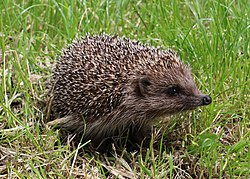Biology:Northern white-breasted hedgehog
| Northern white-breasted hedgehog[1] | |
|---|---|

| |
| Scientific classification | |
| Domain: | Eukaryota |
| Kingdom: | Animalia |
| Phylum: | Chordata |
| Class: | Mammalia |
| Order: | Eulipotyphla |
| Family: | Erinaceidae |
| Genus: | Erinaceus |
| Species: | E. roumanicus
|
| Binomial name | |
| Erinaceus roumanicus Barrett-Hamilton, 1900
| |

| |
| Range of the northern white-breasted hedgehog (blue) | |
The northern white-breasted hedgehog (Erinaceus roumanicus)[3] is a species of hedgehog.
Distribution
The range of the species extends in the west as far as Poland , Austria and the former Yugoslavia, and south to Greece and the Adriatic Islands, including populations on Crete, Corfu and Rhodes. It is found eastwards through Russia and Ukraine , as far east as the Ob River in Siberia.[1] It is widespread throughout this range, and there are no signs of a significant population decline.[2]
Taxonomy
Taxonomically, it was for a time considered to be a subspecies of E. europaeus, and later a subspecies of E. concolor. Since the 1990s, it has been considered a separate species in its own right, following new genetic and morphological studies, with five subspecies - E. roumanicus roumanicus, E. roumanicus bolkayi, E. roumanicus drozdovskii, E. roumanicus nesiotes, and E. roumanicus pallidus.[1]
Variation
In Europe, the size of the northern white-breasted hedgehog (Erinaceus roumanicus) in southern Europe was greater in comparison to white-breasted hedgehog in northern Europe. The size of the northern white-breasted hedgehog varied based on the temperature and precipitation, the size of the white-breasted hedgehog was larger in higher temperatures. The higher the precipitation, specifically summer precipitation, the smaller the size of the white-breasted hedgehog.(Kryštufek et al.,2009)[4]
Parasites
The species is a common synanthrope and is known to carry not only the hedgehog tick, Ixodes hexagonus, but also Ixodes ricinus, the most common European tick species.[5] They are known also to host zoonotic Bartonellae species.[6] A large-scale molecular investigation of fleas was performed to the white-breasted hedgehog due to them being a geographically widespread species and being a very urbanized species. The widespreadness and urbanization of the species gives the white-breasted hedgehog a chance to spread their fleas, specifically Archaeopsylla erinacei, to cats and dogs, which could lead to spread to humans (Gilles et al. 2008).[7] In the investigation, all fleas were positive for rickettsiae (Hornok et al., 2014).[8] In this investigation, 759 fleas were studied, there was detection of Rickettsia helvetica (1.5%),Bartonella henselae (0.7%), hemoplasmas of the hemofelis group (5.2%), and rickettsia genotype were identified (10%)(Hornok et al., 2014).[8]
References
- ↑ 1.0 1.1 1.2 Wilson, D.E.; Reeder, D.M., eds (2005). Mammal Species of the World: A Taxonomic and Geographic Reference (3rd ed.). Johns Hopkins University Press. ISBN 978-0-8018-8221-0. OCLC 62265494. http://www.departments.bucknell.edu/biology/resources/msw3/browse.asp?id=13600021.
- ↑ 2.0 2.1 Amori, G.; Hutterer, R.; Kryštufek, B.; Yigit, N.; Mitsainas, G.; Palomo, L. (2021). "Erinaceus roumanicus". IUCN Red List of Threatened Species 2021: e.T136344A197508156. doi:10.2305/IUCN.UK.2021-1.RLTS.T136344A197508156.en. https://www.iucnredlist.org/species/136344/197508156. Retrieved 12 November 2021.
- ↑ Note that this is sometimes given as Erinaceus romanicus
- ↑ Kryštufek, Boris; Tvrtković, Nikola; Paunović, Milan; Özkan, Beytullah (1 December 2009). "Size variation in the Northern white-breasted hedgehog Erinaceus roumanicus: latitudinal cline and the island rule". Mammalia 73 (4): 299–306. doi:10.1515/MAMM.2009.055.
- ↑ Dumitrache, Mirabela Oana, et al. “Northern White-Breasted Hedgehogs Erinaceus Roumanicus as Hosts for Ticks Infected with Borrelia Burgdorferi Sensu Lato and Anaplasma Phagocytophilum in Romania.” Ticks and Tick-Borne Diseases, vol. 4, no. 3, 2013, pp. 214–217., doi:10.1016/j.ttbdis.2012.11.010.
- ↑ Majerová, Karolina; Gutiérrez, Ricardo; Fonville, Manoj; Hönig, Václav; Papežík, Petr; Hofmannová, Lada; Lesiczka, Paulina Maria; Nachum-Biala, Yaarit et al. (2021-06-01). "Hedgehogs and Squirrels as Hosts of Zoonotic Bartonella Species". Pathogens 10 (6): 686. doi:10.3390/pathogens10060686. ISSN 2076-0817. PMID 34205901.
- ↑ Gilles, Jeremie; Just, Frank Thomas; Silaghi, Cornelia; Pradel, Ingrid; Passos, Lygia Maria Friche; Lengauer, Heidi; Hellmann, Klaus; Pfister, Kurt (2008). "Rickettsia felis in Fleas, Germany - Volume 14, Number 8—August 2008 - Emerging Infectious Diseases journal - CDC". Emerging Infectious Diseases 14 (8): 1294–1296. doi:10.3201/eid1408.071546. PMID 18680660.
- ↑ 8.0 8.1 Hornok, Sándor; Földvári, Gábor; Rigó, Krisztina; Meli, Marina L.; Tóth, Mária; Molnár, Viktor; Gönczi, EnikŐ; Farkas, Róbert et al. (1 January 2014). "Vector-Borne Agents Detected in Fleas of the Northern White-Breasted Hedgehog". Vector-Borne and Zoonotic Diseases 14 (1): 74–76. doi:10.1089/vbz.2013.1387. PMID 24359423. https://www.zora.uzh.ch/id/eprint/91493/1/vbz.2013.1387-Hornok.pdf.
Wikidata ☰ Q903548 entry
 |


